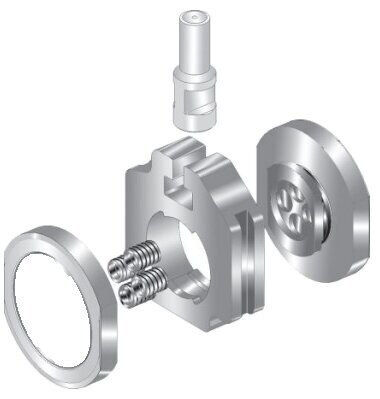The Functionality of Spring Type Parallel Double Gate Valves
Sep 25, 2024
On this page
The spring type parallel double gate valve is a widely used type of valve in industrial piping systems, particularly suited for applications requiring frequent opening and closing operations along with reliable sealing. Its core design features a symmetrically arranged gate structure paired with a spring mechanism, achieving balanced pressure distribution and high sealing efficiency. Whether in high-pressure, low-pressure, or high-temperature environments, this gate valve ensures stable operation and prevents medium leakage effectively.
The gate assembly of the spring type parallel double gate valve consists of several components: left and right gates, a gate frame, springs, a positioning sleeve, and bolts. During valve operation, the spring plays a crucial role by providing balancing force and additional operational torque, ensuring stable operation and reliable sealing of the valve.

The gate assembly is the core of this valve and is composed of multiple parts, including the left and right gates, gate frame, springs, positioning sleeve, and bolts. The spring serves as a critical auxiliary device, typically employing three helical springs to provide balancing force. Due to spatial constraints, small-diameter valves usually come equipped with only one spring, without a positioning sleeve, relying on the valve seat to position the gate. This structural design features the following advantages:
Simple Structure: The components are relatively straightforward, especially for small-diameter valves, eliminating the need for complex positioning devices, resulting in lower manufacturing costs.
Easy Adjustment: The opening and closing dimensions of the valve, along with the spring’s pre-tension force, can be easily adjusted, making processing and maintenance relatively simple.
The opening and closing of the valve depend on the torque generated by the spring. When the valve opens, the spring assists in lifting the gate through its reaction force, facilitating smooth operation. During closure, the spring helps stabilize the gate in the closed position, creating effective sealing to prevent medium leakage. The pre-tension of the spring plays a crucial role in the valve’s opening and closing process; improper adjustment can affect operational flexibility and sealing effectiveness.
The spring in the spring type parallel double gate valve serves multiple functions, including enhancing sealing performance, providing additional operational torque, buffering and dampening effects, and adjusting opening and closing speeds.
During the closing process, the pressure of the medium exerts significant force on the gate, which may lead to uneven stress and affect sealing performance. The spring applies a counterbalancing force, allowing the gate to experience uniform stress, ensuring that the sealing surfaces are tightly fitted, thereby improving the valve's sealing effectiveness.
Opening and closing the valve usually requires considerable torque, especially in high-pressure conditions. The spring provides extra closing or opening torque, allowing operators to easily open or close the valve. Its function acts as an auxiliary device, reducing the manual or automatic operation load and enhancing operational efficiency.
In scenarios where medium flow rates are high or pressure fluctuations are significant, the valve may experience severe vibrations, affecting its stability and accelerating wear. The spring can absorb and buffer some of these vibrations and impacts, thus reducing damage to the internal components of the valve and extending its service life.
In certain applications, controlling the opening and closing speeds of the valve is vital. By adjusting the spring's stiffness or pre-tension, the movement speed of the gate can be modified, ensuring precise control of the valve under varying conditions. This is particularly important for systems with strict operational time requirements.
Although the spring plays multiple roles in valve operation, adjusting its force is a key issue. Improper adjustment can affect the normal functioning of the valve.
Excessive Spring Force: The valve becomes inflexible and difficult to operate, particularly during closure when excessive pressure on the sealing surfaces accelerates wear and affects the valve's lifespan.
Insufficient Spring Force: In the closed state, the spring may fail to provide adequate force to maintain the necessary pressure differential at the sealing surfaces, leading to leaks, especially in low-pressure environments.
Additionally, under high-temperature conditions, the spring may fail due to prolonged exposure to heat, causing force decay or complete loss of function. Therefore, regular inspection and maintenance of the spring are essential to ensure its functionality during use.
To ensure the long-term stable operation of the parallel double gate valve, the springs and valve components require regular inspection and maintenance.
Regularly Adjusting Spring Pre-Tension: Adjust the spring's pre-tension according to operating conditions to avoid excessive or insufficient spring force affecting operational performance.
Inspecting Spring Condition: Particularly in high-temperature and high-pressure environments, springs are prone to fatigue failure due to prolonged stress, necessitating regular replacement of any failed springs.
Maintaining Sealing Surfaces: Sealing surfaces wear during valve operation; regular inspection and maintenance can effectively extend the valve's lifespan.
The spring type parallel double gate valve achieves balanced torque distribution and efficient sealing performance through its unique gate and spring structure design. It excels in pressure regulation, ease of operation, and vibration resistance, making it widely applicable across various industrial fields, including petroleum, chemical, and power. However, to ensure its longevity and stable performance, it is crucial to adjust the spring force appropriately based on actual operating conditions and conduct regular maintenance and inspections. With proper management and routine care, the parallel double gate valve will continue to play a vital role in complex industrial applications.
Next: Major Differences between Piston Valves and Globe Valves
Previous: Lift Check Valves vs. Globe Valves: Structural and Application
About Us
Categories
Useful Links
Our Contacts
Building 2, NO.59, Songshan Road, SND, Suzhou, China
